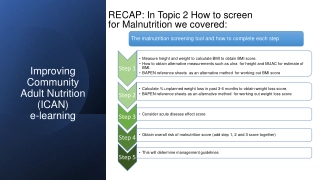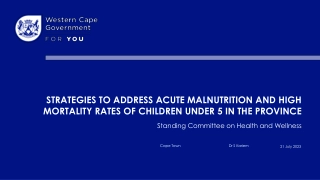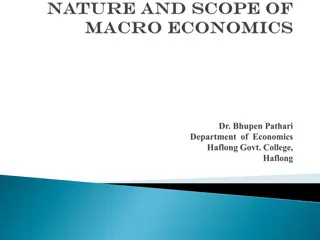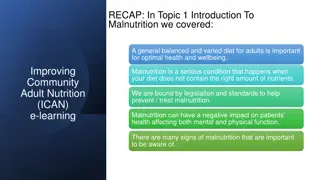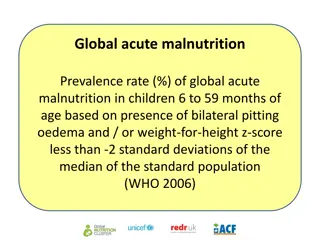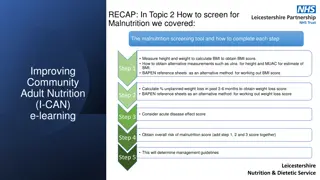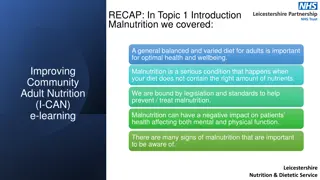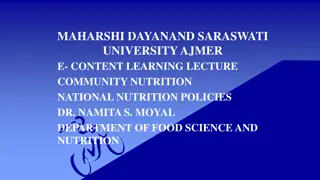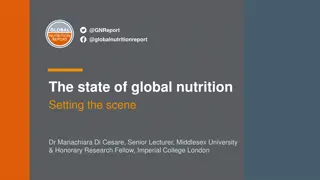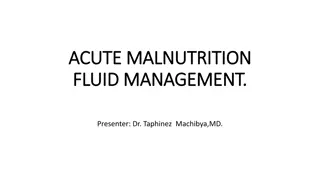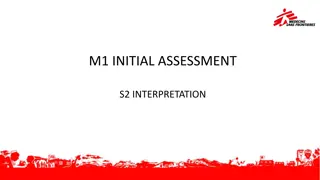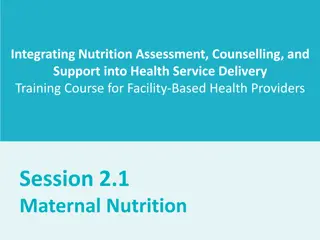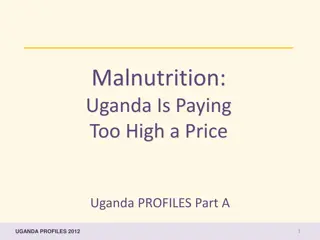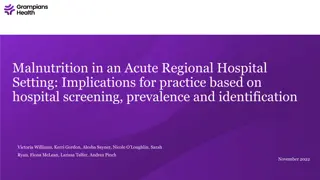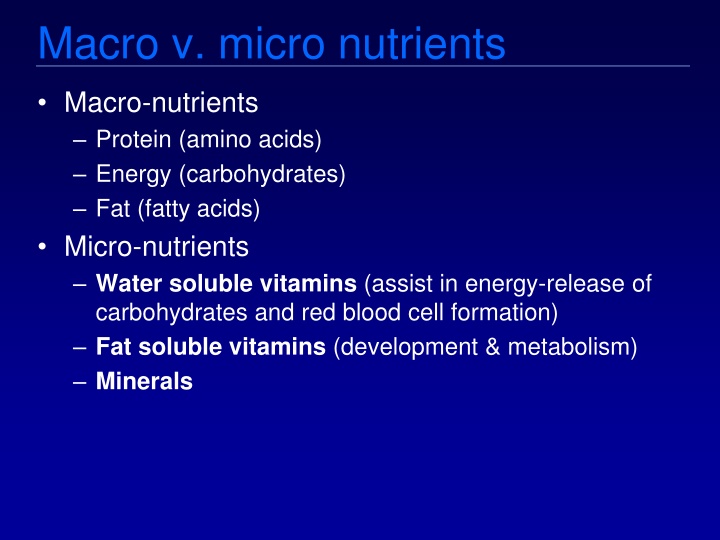
Macro and Micro Nutrients in Human Nutrition
Learn about the importance of macro and micro nutrients in human nutrition, including details on protein, carbohydrates, fats, vitamins, and minerals. Discover the impact of malnutrition and the Geneva Declaration's significance in advocating for children's right to nutrition.
Download Presentation

Please find below an Image/Link to download the presentation.
The content on the website is provided AS IS for your information and personal use only. It may not be sold, licensed, or shared on other websites without obtaining consent from the author. If you encounter any issues during the download, it is possible that the publisher has removed the file from their server.
You are allowed to download the files provided on this website for personal or commercial use, subject to the condition that they are used lawfully. All files are the property of their respective owners.
The content on the website is provided AS IS for your information and personal use only. It may not be sold, licensed, or shared on other websites without obtaining consent from the author.
E N D
Presentation Transcript
Macro v. micro nutrients Macro-nutrients Protein (amino acids) Energy (carbohydrates) Fat (fatty acids) Micro-nutrients Water soluble vitamins (assist in energy-release of carbohydrates and red blood cell formation) Fat soluble vitamins (development & metabolism) Minerals
Macro-nutrients Energy Necessary for all bodily function Protein Necessary for structural development (muscle and bone) Fat Necessary for cell membrane and skin cell development
Dietary Reference Intakes Macronutrient F (19-30 y.o.) M (19-30 y.o.) Energy (Kcal) 1940 2200 2550 2900 Protein (g) 36 46 44 60 Fat 15 33% 15 33%
Summary: Nutritional requirements In order to live and function, humans need macro- and micro- nutrients; Macro-nutrients are fat, protein and carbohydrates; Micro-nutrients are water-soluble vitamins, fat-soluble vitamins, and minerals (bone and trace); the most critical micro-nutrients are iron, iodine, zinc, vitamin A and vitamin D.
What is malnutrition? World Health Organization definition: The term is used to refer to a number of diseases, each with a specific cause related to one or more nutrients (for example, protein, iodine or iron) and each characterized by cellular imbalance between the supply of nutrients and energy on the one hand, and the body's demand for them to ensure growth, maintenance, and specific functions, on the other.
Geneva Declaration 1924:Declaration of the Rights of the Child (also known as the Declaration of Geneva). Adopted after World War I by the League of Nations through the efforts of British child rights pioneer Marks the beginning of the international child rights movement and is also the first international affirmation of the right to nutrition. Affirms that "the child must be given the means needed for its normal development, both materially and spiritually" and states that "the hungry child should be fed."
Summary: Definition of malnutrition Malnutrition is having the inappropriate level of a micro- or macro- nutrient; In some cases (i.e. the US), malnutrition can be associated with being grossly overweight; In most of the world, malnutrition is defined as a LACK of nutrients; Malnutrition contributes to over 50% of deaths in children in the world.
Causes of malnutrition Child malnutrition death and disability Inadequate Diet Disease Inadequate maternal and child care Poor water/ sanitation inadequate health services Insufficient access to food
Summary: Causes/correlates Malnutrition rarely exists in isolation, and many other factors contribute to its detrimental impact; Poor physical resources, and overcrowded homes Poor sanitation and water supply Low income Parents with little education Minimal interaction/stimulation in the home Malnutrition has repercussions throughout the life cycle and is thus multi-generational (diagram with lots of arrows)
Impaired mental development Higher mortality rate Increased risk of adult chronic disease Reduced capacity to care for baby Baby Low Birth Weight Untimely/inadequate weaning Frequent Infections Inadequate food, health Elderly Malnourished Inadequate catch up growth Inadequate fetal nutrition Inadequate food, health & care & care Child Stunted Reduced mental capacity Woman Malnourished Adolescent Stunted Pregnancy Low Weight Gain Inadequate food, health & care Start here Reduced mental capacity Inadequate food, health & care Higher maternal mortality
Types of malnutrition Severe Protein-Energy Malnutrition (>3 S.D.) Kwashiorkor (low protein) Marasmus (low calories) Mild/moderate undernutrition (>2 S.D.) Stunting Underweight Wasting Micro-nutrient deficiency Iodine Iron Vitamin A Vitamin D
Measurement of Malnutrition STUNTING: Height for age height compared to a reference population of the same age. = represents long term growth retardation UNDERWEIGHT: Weight for age weight compared to age in a reference population WASTING: Weight for height weight compared to a reference population of the same height.
Summary: Measurement There are several types of malnutrition, micro- and macro-malnutrition; Measurement of severe malnutrition (>3 S.D.) and micro-nutrient deficiency usually occurs due to presence of critical signs (to be discussed); Measurement of mild/moderate malnutrition (>2 S.D.) occurs with growth charts.
Severe malnutrition % <5 y.o. 20% 18% South Asia 16% 14% Sub-Saharan Africa 12% 10% Middle East and North Africa CEE/CIS & Baltic States Latin America & Caribbean 8% 6% 4% 2% 0% % Developing Countries Least Developed Countries (India 21%, Bangladesh 21%, Cambodia 18%) Data for 1992-98, UNICEF State of the World s Children 2000 12% 13%
Kwashiorkor Infection Sparse hair Swollen belly Decreased muscle mass Pellagra Apathy
Kwashiorkor (low protein) Decreased muscle mass (failure to gain weight and of linear growth) Swollen belly (edema and lipid build-up around the liver) Changes in skin pigment (pellagra); may lose pigment where the skin has peeled away (desquamated) and the skin may darken where it has been irritated or traumatized Hair lightens and thins, or becomes reddish and brittle. Increased infections and increased severity of normally mild infection, diarrhea Apathy, lethargy, irritability Death does not occur from actual starvation but from secondary infection
Kwashiorkor mechanisms Occurs in reaction to emergency situations (famine) Kwashiorkor more likely in areas where cassava, yam, plantain, rice and maize are staples, not wheat Increased carbohydrate intake with decreased protein intake eventually leads to edema (water) and fatty liver
Marasmus (low calories) Ravenously hungry Gross weight loss & no fat
Marasmus Deficit in calories marasmus comes from Greek origin of word to waste Gross weight loss Hyper-alert and ravenously hungry Children have no subcutaneous fat or muscle eventually starve to death (immediate cause often is pneumonia)
Marasmus mechanism Energy intake is insufficient for body s requirements body must draw on own stores Liver glycogen exhausted in a few hours skeletal muscle protein used via gluconeogenesis to maintain adequate plasma glucose When near starvation is prolonged, fatty acids are incompletely oxidized to ketone bodies, which can be used by brain and other organs for energy High cortisol and growth hormone levels Mechanism is same as anorexia
Severe Malnutrition: Consequences Mental development Lower IQ levels Poorer school performance Behaviors of recovered severely malnourished children shy, isolated, withdrawn decreased attention span immature, emotionally unstable fewer peer relationships/reduced social skills played less/stayed nearer to mothers
Summary: Severe malnutrition Severe malnutrition is defined as > 3 s.d. away from median reference standards; 66M children under the age of 5 are severely malnourished (64M of these in developing countries); Key types of severe malnutrition are kwashiorkor (low protein) and marasmus (low calories); Severe malnutrition results in severe deficits for children
Stunting Height for Age Height for age reflects pre- and post- natal linear growth Stunting refers to shortness that is not genetic, but due to poor health or nutrition Most standard definition < 2 S.D. Stunting is good cumulative measure of well-being for populations of children (because not affected by weight recovery)
Where do we go from here? Poverty reduction Economic growth Increased productivity Improved child nutrition Social sector investments Enhanced human capital From UNICEF, State of the World s Children: Adapted from Stuart Gillespie, John Mason and Reynaldo Martorell, How nutrition improves, ACC/SCN, Geneva 1996.



